Launch of the Shuttle Discovery : Sheer Number of Modifications Produces New Debate on Safety
- Share via
KENNEDY SPACE CENTER, Fla. — The space shuttle Discovery, due to lift off today, looks identical to its sister spacecraft that have been launched into orbit here. But it isn’t.
In the 2 1/2 years since the Challenger disaster, more than 400 alterations have been made in the winged spaceplane by engineers at the National Aeronautics and Space Administration. In all, the changes mean that the Discovery is the most redesigned shuttle since the first shuttle test flight in 1981.
The most important alteration, of course, is the new configuration of the joints that seal together sections of the shuttle’s huge booster rockets. It was one of these joints that leaked hot gases during the launching of the Challenger in 1986 and ultimately led to its destruction.
Other changes reach into virtually every system aboard the craft. They range from the seemingly trivial, such as new routing for a wire, to the obviously dramatic. The latter category includes new escape systems for the astronauts and improvements in wheel brakes that chronically burned out during past landings.
Problems Feared
Although many of the modifications were made to increase the safety of the vehicle, the sheer number of the changes has produced a debate both inside NASA and outside. The critics argue that any change, even one made for safety reasons, can produce problems if the vehicle does not perform as expected. As the number of changes increases, they say, so do the risks.
Asked to list the most failure-prone parts on the shuttle, John Pike, head of space policy for the American Federation of Scientists, replied, “Everything they’ve fixed.”
“No amount of ground testing will substitute for experience in space, and new hardware has a way of fooling you,” Pike added.
A program head at NASA’s Johnson Space Center in Houston, who asked not be identified, said some specific risks resulting from the changes have been identified, largely involving increased weight. In all, he said, the modifications have added about half a ton of weight to the vehicle. That additional weight will make it more crucial to get maximum burn from the rocket engines during the launching and would also mean the shuttle would descend at a steeper rate during the landing.
“You build in an extra layer of safety in one place, and take it away somewhere else. In some of these cases it’s hard to say whether you have a net gain or not,” he said.
Ground Testing Extensive
Clearly, NASA has decided that the modifications--known as “mods” in NASA shorthand--add more safety to the vehicle than they subtract. Gary Coultas, assistant manager of the orbiter project in Houston, says ground testing of new parts is so extensive that he believes there is little risk of a dangerous failure in the parts themselves.
What Coultas does fear is the damage that can be inflicted on the shuttle when technicians install the modifications. Spacecraft are not designed for easy access to their internal parts, Coultas says, and it is easy for an installer working in cramped quarters to crush wiring or cut into soft materials next to the new part.
Every installation is checked and re-checked by different inspectors to find such damage. “Still,” he said, “the risk is there. You’ve got to have faith that the (checking) works, “ he said.
The space shuttle has often been described as the most complex machine ever built, and that complexity--plus the inherent danger of space travel--is revealed in some of the modifications to the craft’s three liquid fuel engines.
The three nozzles of these engines are grouped at the rear of the craft and are ignited moments before the huge solid-fuel boosters light up the sky during liftoff. The engines burn a mixture of liquid hydrogen and oxygen that is pulled from the tanks, gasified, and forced into the combustion chambers at an awesome rate by turbo pumps.
The draining of the tanks is so fast--hydrogen is being pulled out at the rate of 16,000 gallons per minute--that they would collapse if the tanks are not simultaneously re-pressurized. Thus, a valve in the liquid fuel engine captures a portion of the hot gasified oxygen or hydrogen just before it enters the combustion chamber and redirects it back into the liquid tank. The same process takes place with hydrogen.
Valve Tolerates Stress
The valve that performs this task is a wonder. The gasified oxygen is so hot and running at such high pressures that it would ignite most metals. The shuttle’s valve tolerates the stresses but when NASA engineers tested the valve they discovered a potential problem with the coating of the valve. If tiny metal particles got caught in the oxygen stream, they could adhere to the coating. The extra heat from the particles could cause the valve itself to burn. Such a burn would be catastrophic, probably causing the craft to explode.
No oxygen valve has ever burned during an actual flight. Nonetheless NASA searched for and found another coating material for the valve that would tolerate the added heat of tiny, metal particles. The coating was applied and Discovery will fly with the new, modified valves.
Although some changes in Discovery are being made to increase performance, most reflect the post-Challenger concentration on safety. A potentially troublesome valve that controls fuel flow from the external tank has been fitted with a fail-proof latch. The turbo-pumps that push fuel into the liquid engines have new blades to reduce breakage. Some of the ceramic, thermal tiles on the shuttle’s skin have been replaced with new, composite tiles.
And in one case, there is a modification of a modification. Wing struts have been strengthened in the Discovery, reversing a previous change that reduced the size of the struts to save weight. NASA engineers say the struts were beefed up after actual flights showed that stresses on the wings were greater than had been indicated by wind tunnel tests.
Of course, the Discovery is not the first shuttle to undergo changes. Each of the three existing orbiters--a fourth is now under construction to replace the Challenger--have all been modified and are, in some ways, unique space craft.
Sometime in the future, for example, a redesign of the liquid-fuel engines will produce more lifting power for the shuttle. And NASA engineers also are working on lighter casings for the solid-fuel boosters.
Pushes to Threshold
“We are continuously involved in a technology that pushes materials to the threshold of their endurance,” said Ray Tjulander, manager of NASA’s liquid engine operation in Canoga Park. “It is inherently dangerous to do that. The key is to measure the risks, to know what you are doing, and then decide whether you will proceed or not.”
Tjulander said he was confident that changes made to the liquid-fuel engines have not increased the risks over those of previous flights. Rather, he argues, the engines almost certainly are safer now than before.
Just to be sure, Tjulander says, the liquid engines will be operated at a pitch somewhat lower than normal for the Discovery launch. In past flights the engines were brought to a peak that represented 104% of their designed maximum power. At this launch, he said, the peak will hit only 100%.
THE MISSION DAY 1 Launch from Kennedy Space Center. Six hours into flight, astronauts will deploy a communications satellite. The $100-million satellite will remain in a stationary orbit 22,300 miles over the Pacific Ocean. DAY 2 Eleven science and technology experiments. DAY 3 More experiments. Astronauts don spacesuits. DAY 4 News conference from space. Pre-landing checks. DAY 5 Landing at Edwards Air Force Base. CHANGES TO THE SPACE SHUTTLE There have been about 400 design changes to the space shuttle orbiter, to the rockets and engines since the explosion of the Challenger in January, 1986. Officials say they will make the Discovery safer, among other things. Among the changes: THE ORBITER Addition of an escape hatch, with an extending pole to allow crew member to slide down and parachute to safety during landing External changes include improved heat absorbing tiles, changes to the landing gear, strengthening of the wing structure and engine pod. More than 200 internal changes include electrical rewiring and improvements in the braking and steering systems. EXTERNAL TANK--Eight changes, including new battery, strengthened fuel line housing, redesign of the explosive bolt that disconnects electrical cables. BOOSTER ROCKETS-More than 140 changes, including extra-0-rings in the joints, among the items criticized in the Challenger accident Improvements to internal insulation, fuel igniter, the nozzle and bracket holding the booster in place. THE ENGINES-About 30 changes, including strengthened bearings, fuel valve housings and turbopump blades, improvements in hydraulic equipment and temperature sensors.
More to Read
Sign up for Essential California
The most important California stories and recommendations in your inbox every morning.
You may occasionally receive promotional content from the Los Angeles Times.










